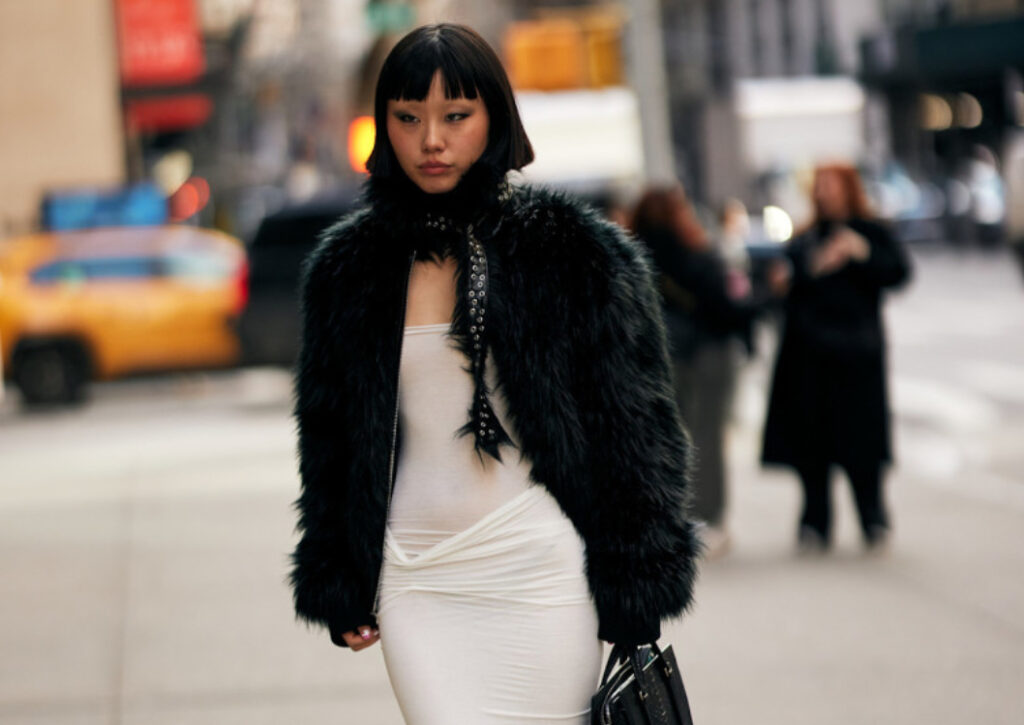
The Return of Fur in Fashion
A fur coat is one thing. Everyone from Cam’ron to Princess Diana has worn one of those. But fashion’s current obsession with fur goes far beyond the opulent outerwear of yesteryear. In the wake of TikTok’s mob wives ransacking vintage stores for grandma’s chinchilla coats, anything and everything is suddenly sprouting fur like a Chia Pet gone rogue. Formal loafers are growing big bushy tails, hairy hats are absurdly oversized, Rosalia’s walking around in a Celine fur dress that looks like a huge pom pom: Fashion has gotten real hairy.
This excerpt, both humorous and accurate, summarizes the moment we’re in: fur is not just back — it’s everywhere, and it’s louder, campier, and more exaggerated than ever before. This 2025 fur trend — driven as much by digital aesthetics as historical nostalgia — reveals deeper truths about where fashion is headed, how trends are recycled, and why this one may stick around far longer than expected.
A Return with a Twist: Understanding the Origins of the Furry Revival
The reemergence of fur in fashion isn’t simply about bringing back luxury. Rather, it’s about recontextualizing it. Gone are the slick, severe coats of the 1980s power elite or the glamorous fox stoles of old Hollywood. In 2025, fur is performative, chaotic, and deliberately extra. It’s a fashion weapon — deployed for impact on runways, red carpets, and TikTok feeds alike.
This revival was seeded years ago through irony-laced nostalgia and digital culture’s thirst for tactile, photogenic materials. The TikTok-driven mob wife aesthetic, which glorifies oversized gold jewelry, animal prints, and vintage fur, lit the initial flame. Think Carmela Soprano energy meets 2025 filter culture — luxe and messy at once. But it didn’t stop with coats. Designers began adding fur to unexpected garments: collars, loafers, cargo pants, balaclavas. Then came fully furred dresses, handbags with pelts, and surrealist looks resembling animated plush.
In many ways, the current wave is less about fur itself and more about fashion’s embrace of volume and texture in the age of overexposure. Fur — or fur-like material — photographs well, moves dramatically, and evokes decadence with a hint of irony. That blend makes it perfect for an era where attention is everything.
Cultural Touchpoints: From Cam’ron to Celine
To understand why this trend hits so hard in 2025, it helps to look back. Fur has always held symbolic weight. It’s regal. It’s rebellious. It’s genderless and genreless — worn by rappers, royals, drag queens, and punks alike.
Cam’ron’s bubblegum pink mink coat at New York Fashion Week in 2002 became a hip-hop fashion artifact. Princess Diana’s tailored fox coats of the 1980s signaled poise and confidence in public life. Andre Leon Talley draped himself in voluminous capes lined in fur. Even Dennis Rodman, never afraid of fashion risk, sported dyed furs during his NBA heyday.
In 2025, those references are reappearing, but with cartoonish flair. Rosalia’s Celine pom-pom fur dress at the Latin Grammys trended for days not just because it was luxe — but because it was funny. Loewe’s surrealist fall collection added fur to objects where it didn’t belong: pillows, flowerpots, slippers with human toes. Marc Jacobs’ New York show this February featured a floor-length yeti coat worn over micro shorts — both absurd and covetable.
Social media, too, plays a pivotal role. Furry accessories and statement coats dominate on TikTok and Instagram, where visual excess wins. Gen Z’s comfort with irony and maximalism makes them perfect carriers of the trend. When mob wife meets meme culture, fur thrives.
Real or Faux: The Material Question
No discussion of fur is complete without acknowledging its political baggage. In the early 2000s, anti-fur campaigns were dominant. PETA’s high-profile protests and the shift toward sustainability put fur on the defensive. Many fashion houses — including Gucci, Chanel, Burberry — went fur-free.
So how does the current resurgence navigate that ethical terrain?
The answer: most of it is faux — and proudly so. Advances in synthetic fur production mean today’s faux furs are virtually indistinguishable from the real thing, at least to the naked eye. They’re also more colorful, experimental, and easier to work with. Brands like Shrimps, Stella McCartney, and House of Sunny have embraced faux fur as both ethical and creative territory. Even heritage houses like Fendi and Prada — once bastions of real fur — now explore synthetics in capsule collections.
For young consumers, the question isn’t always “Is it real?” but “Does it feel bold?” In this context, fur is less about luxury status and more about signaling taste, performance, and fashion fluency. It’s about embracing a fashion language that is tactile, nostalgic, and visually explosive — without the moral complexity of animal cruelty.
Why It Prevails: Emotional Armor in Wild Times
Fur, especially in its most exaggerated forms, offers more than aesthetic pleasure. It provides emotional shelter. In an era of political chaos, climate anxiety, and economic precarity, fashion has increasingly leaned into fantasy. We saw it post-pandemic in the return of surreal silhouettes, ultra-platform shoes, and doll-like makeup. Fur fits this escapist narrative.
Oversized coats with shaggy collars feel like armor. Furry boots and hoods act like wearable comforters. Even the idea of “hiding inside a pelt” evokes the cocooning instincts that have shaped post-2020 fashion. Consumers want to feel wrapped, protected, and seen. Fur offers all three.
There’s also a cultural boldness to fur. In an age where taste is often policed and understated minimalism still rules certain fashion corners, fur refuses to whisper. It roars. And for marginalized communities — queer creatives, rappers, women asserting space — fur becomes a form of self-expression that resists invisibility.
The Future: Where Does Fur Go From Here?
So where does this all lead? Is the fur craze just another meme-worthy microtrend, or does it have legs (and tails)?
Here’s what to expect in the coming seasons:
Fur as Accent, Not Anchor
Designers will increasingly incorporate fur into garments that don’t traditionally feature it. We’ve already seen furry cargo pants and tube tops. Expect to see fur-trimmed denims, techwear with fleecey textures, and even gymwear with faux-fur panels.
Tech-Driven Textures
Material science is accelerating. Look for fur that lights up, changes color based on heat, or reacts to sound. Brands like Coperni and The Fabricant (in the digital fashion world) are already merging fur textures with tech.
Color Explosion
Say goodbye to neutral mink tones. The future of fur is neon, pastel, metallic. Think rave-inspired fur jackets, holographic fur trims, and cartoon-coded accessories in bubblegum hues.
Sustainable Luxury
Faux fur innovation is booming. Bio-based synthetics and recycled alternatives will gain traction. Brands will compete not just on texture but on eco-credibility, and fur won’t be exempt from transparency expectations.
Fur in Menswear Renaissance
As gendered fashion norms continue to dissolve, fur is becoming a staple in menswear. Expect to see fur vests, fur-lined tailoring, and gender-neutral wraps on runways from Paris to Seoul.
Impression
Fashion’s renewed obsession with fur isn’t random. It’s a calculated, chaotic response to a world that feels out of control. Fur — in all its exaggerated, tactile glory — provides a sense of luxury, drama, and even defiance. It’s maximalist, memeable, and deeply human. It asks nothing of us but to feel something. And in that way, it makes perfect sense for 2025.
No comments yet.








